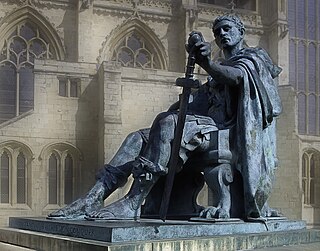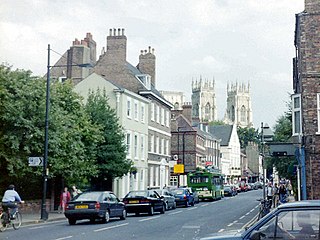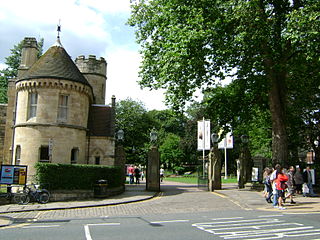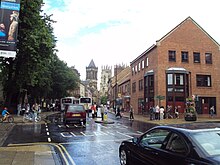
Clifton is a suburb of York in the unitary authority of the City of York, in the north of England about 1+1⁄2 miles from the city centre. The A19, passes north out of York through Clifton.

Eboracum was a fort and later a city in the Roman province of Britannia. In its prime it was the largest town in northern Britain and a provincial capital. The site remained occupied after the decline of the Western Roman Empire and ultimately developed into the present-day city York, occupying the same site in North Yorkshire, England.

There are nine bridges across the River Ouse and sixteen smaller bridges and passages across the narrower River Foss within the city of York, England.

The Abbey of St Mary is a ruined Benedictine abbey in York, England and a scheduled monument.

Bootham is a street in the city of York, in England, leading north out of the city centre. It is also the name of the small district surrounding the street.

York has, since Roman times, been defended by walls of one form or another. To this day, substantial portions of the walls remain, and York has more miles of intact wall than any other city in England. They are known variously as York City Walls, the Bar Walls and the Roman walls. The walls are generally 13 feet (4m) high and 6 feet (1.8m) wide.

The history of York, England, as a city dates to the beginning of the first millennium AD but archaeological evidence for the presence of people in the region of York dates back much further to between 8000 and 7000 BC. As York was a town in Roman times, its Celtic name is recorded in Roman sources ; after 400, Angles took over the area and adapted the name by folk etymology to Old English Eoforwīc or Eoforīc, which means "wild-boar town" or "rich in wild-boar". The Vikings, who took over the area later, in turn adapted the name by folk etymology to Norse Jórvík meaning "wild-boar bay", 'jór' being a contraction of the Old Norse word for wild boar, 'jǫfurr'. The modern Welsh name is Efrog.

The York Museum Gardens are botanic gardens in the centre of York, England, beside the River Ouse. They cover an area of 10 acres (4.0 ha) of the former grounds of St Mary's Abbey, and were created in the 1830s by the Yorkshire Philosophical Society along with the Yorkshire Museum which they contain.

Holgate is a suburb of York in England. It is located about 1 mile west of Micklegate Bar in the city walls. Holgate is also the name of an electoral ward in the City of York unitary authority. The ward is currently bounded by the River Ouse from Scarborough Bridge to Ouse Acres on its northern boundary. Carr Lane and Ouse Acres on one side, and the intersection of York Road and Acomb Road on the other, make up its western boundary. The remainder of the southern boundary follows Moorgate and Holgate Beck to the East Coast Main Line railway which completes the eastern boundary as far as the River Ouse/Scarborough Bridge.

York City Rowing Club is a rowing club by the River Ouse in York, England. It has over 200 members, of all ages. The boathouse is on the west bank of the river next to Lendal Bridge and in Memorial Gardens. The club has modern buildings but is three years older than the oldest coastal rowing club in Britain, Dover; it is 25 years younger than the oldest non-academic rowing club, Leander. The reach of canalised river it enjoys is unusually long – over 20 mi (32 km).

Lendal Tower is a medieval tower that formed part of the city defences of York, England. It is located on the east bank of the River Ouse at the point where the river enters the walled city from the north-west. The building was used as a waterworks from 1616 until 1846 after which it was converted into offices. It has since been turned into rental accommodation.

Lendal is a street in the city centre of York, in England.

Coney Street is a major shopping street in the city centre of York, in England. The street runs north-west from the junction of Spurriergate and Market Street, to St Helen's Square. New Street leads off the north-east side of the street, as does a snickelway leading to the Judge's Court hotel, while several snickelways lead from the south-west side down to the River Ouse, including Blanshard's Lane, and paths leading to City Screen.

Skeldergate is a street in the city centre of York, in England. The street is now primarily residential, with many of its warehouse buildings having been converted into apartments.

Duncombe Place is a street in the city centre of York, in England.

St Leonard's Place is a street in the city centre of York, in England.

Spurriergate is a short street in the city centre of York, in England.

Gillygate is a street in York, in England, immediately north of the city centre.

Marygate is a street in York, England, running just north of the city centre. Built in the Middle Ages, it gets its name from St Mary's Abbey and the Viking word "gata," meaning street. The area where the street lies was outside the walls of the Roman city of Eboracum, and represented the northern limit of the settlement; to the north, the land was used only for burials. The street runs south-west, from Bootham, down to the River Ouse.

River House is a historic building in the city centre of York, in England.






















